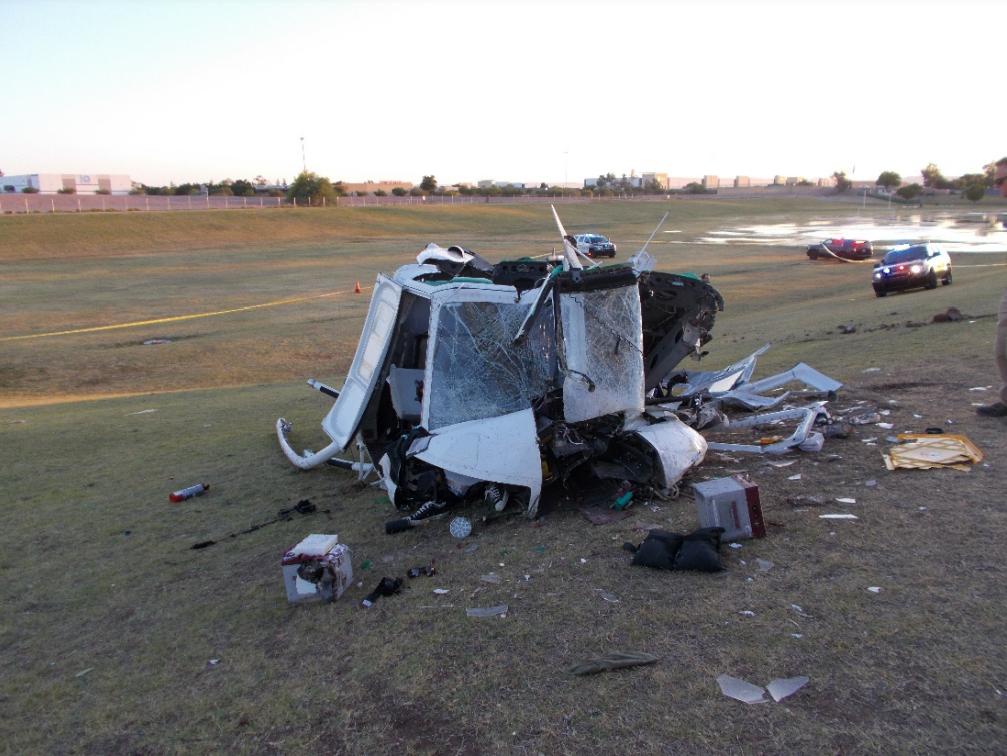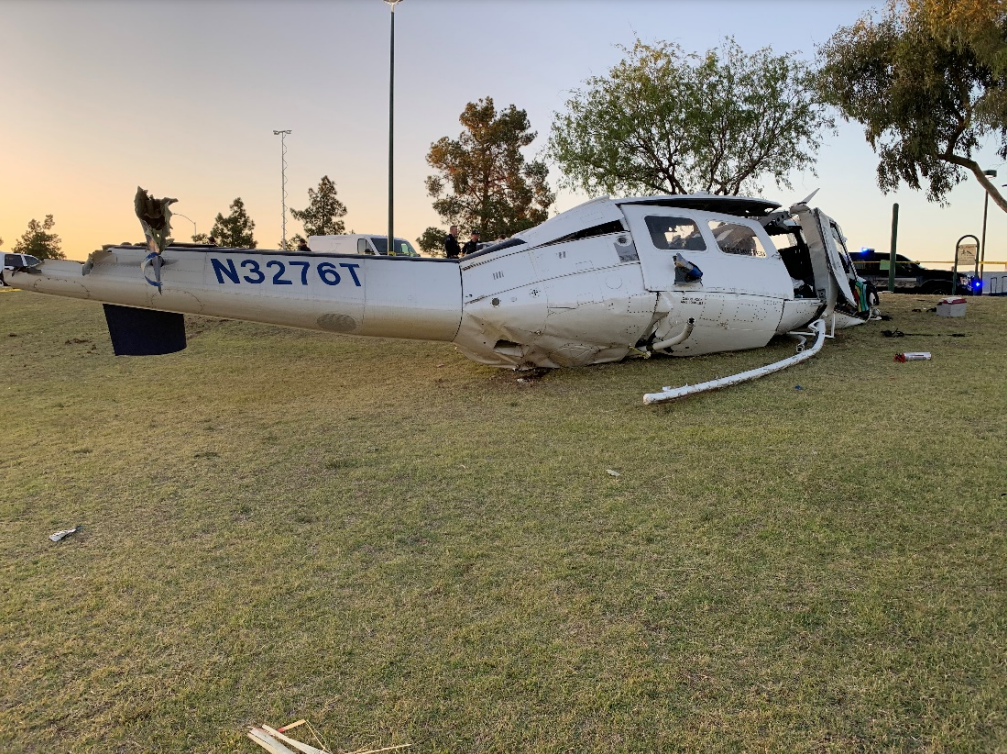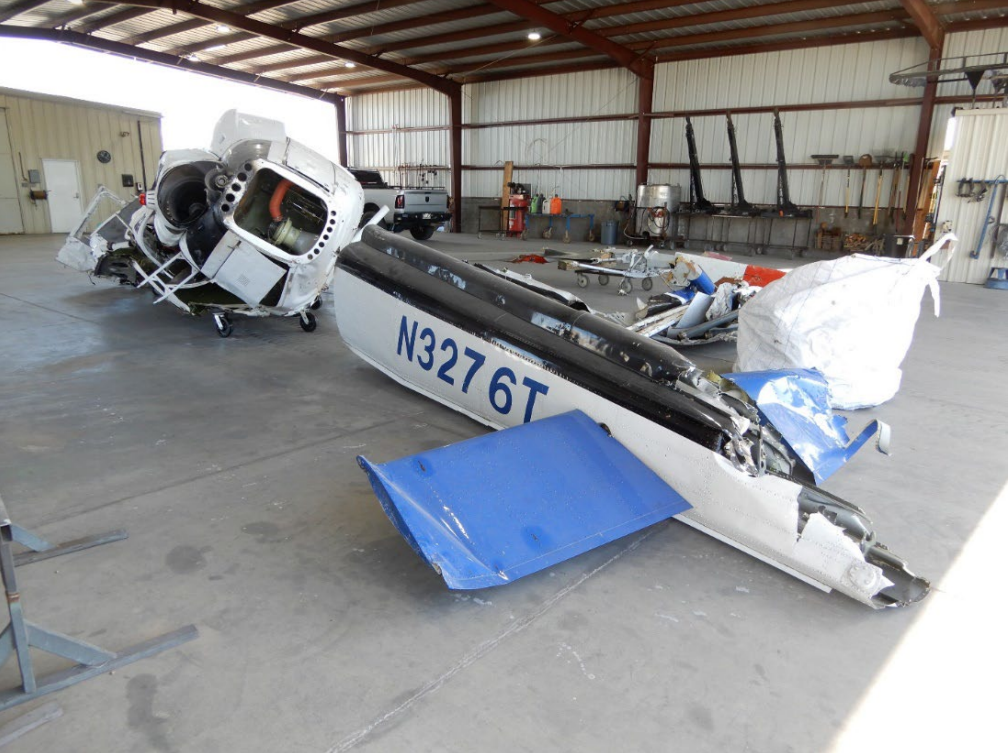
ASN Wikibase Occurrence # 235487
This information is added by users of ASN. Neither ASN nor the Flight Safety Foundation are responsible for the completeness or correctness of this information.
If you feel this information is incomplete or incorrect, you can submit corrected information.
| Date: | Friday 24 April 2020 |
| Time: | 16:00 |
| Type: |  Bell UH-1H Iroquois |
| Owner/operator: | VNC LLC |
| Registration: | N3276T |
| MSN: | 12199 |
| Year of manufacture: | 1969 |
| Total airframe hrs: | 11931 hours |
| Engine model: | Honeywell T53-L-703 |
| Fatalities: | Fatalities: 1 / Occupants: 2 |
| Aircraft damage: | Destroyed |
| Category: | Accident |
| Location: | Mesa, AZ -
 United States of America United States of America
|
| Phase: | En route |
| Nature: | Ferry/positioning |
| Departure airport: | Thermal Airport, CA (TRM/KTRM) |
| Mesa Airport, AZ (FFZ) | |
| Investigating agency: | NTSB |
| Confidence Rating: |
Witnesses reported they observed the helicopter flying low with white smoke emitting from the rear rotor area. Suddenly, the tail rotor separated from the helicopter and landed in a dirt lot below. The helicopter continued northeast as it started to spin and impacted the ground.
Postaccident examination of the engine revealed no preimpact anomalies. The top of the vertical stabilizer, tail rotor assembly, tail rotor gearbox, input quill assembly, and mounting studs were examined. Progressive crack growth was noted on the mounting studs within the tail rotor gearbox housing. The fracture surfaces were relatively rough, consistent with low-cycle fatigue or cyclic overstress crack growth under relatively high cyclic stresses. Additionally, multiple layers of primer, paint, and sealant were observed on the input quill assembly, including paint on the flange clamping surface where it had mated to the vertical stabilizer. Paint was also observed on the vertical stabilizer support casting where it had mated to the input quill as well as the washers for the tail rotor gearbox attachment hardware. In 2012, the gearbox was removed from another helicopter, repaired, painted, and installed on the accident helicopter. There was no other information regarding the installation.
In January 2019, the helicopter was painted and photographs that were taken during this process indicated that the tail boom, tail rotor gearbox, and tail rotor assembly remained installed during the painting process. In addition, the tail rotor assembly and tail rotor gearbox were masked. Therefore, the paint found on the contact mounting surfaces was likely applied during the gearbox installation in 2012; however, the maintenance logs did not provide detailed information of the painting process.
In April 2019, the tail rotor gearbox was removed from the vertical stabilizer for a corrosion inspection; no defects were noted in the maintenance logs. A retorque and/or torque stabilization check was not completed after the gearbox was installed, nor was it required to be according to applicable technical manuals.
The presence of paint on the contact surfaces between the tail rotor gearbox and vertical stabilizer can lead to excessive relaxation of clamping forces due to compressive creep deformation of the paint. Therefore, the improper application of paint on the contact surfaces, which would have been disturbed during the last tail rotor gearbox removal about 39 flight hours prior to the accident, was likely a factor in the eventual reduction in clamping force of the tail rotor gearbox installation onto the vertical stabilizer. However, improper torque of the retaining nuts would also affect the clamping force between the tail rotor gearbox and the vertical stabilizer, but it could not be determined if the retaining nuts were properly torqued during the tail rotor gearbox’s reinstallation after the corrosion inspection in April 2019. The reduction in clamping force on the installation led to the initiation of fatigue fractures on the attachment studs and subsequent separation of the tail rotor gearbox from the vertical stabilizer in flight. The separation of the tail rotor gearbox resulted in a loss of directional control of the helicopter. Had a retorque and/or torque stabilization check of the gearbox retaining nuts been required, it could have identified the reduction in clamping force of the tail rotor gearbox’s installation onto the vertical stabilizer prior to the accident.
The detected levels of oxycodone and its psychoactive metabolite oxymorphone in the pilot’s specimen are most consistent with some degree of tolerance to the effects of oxycodone, indicating regular use. Although it is likely that the pilot was impaired to some degree by the effects of oxycodone at the time of the accident, pilot impairment is unlikely to have contributed to the accident circumstances given that the tail rotor assembly separated in flight.
Probable Cause: An in-flight separation of the tail rotor gearbox from the airframe due to fatigue failure of the gearbox attachment studs, resulting in a loss of directional control and subsequent ground impact. Contributing to the accident were 1) the improper application of paint on the clamping surfaces between the tail rotor gearbox and the vertical stabilizer that led to the initiation of fatigue fractures on the gearbox attachment studs and 2) the lack of a requirement to check the torque of the gearbox attachment hardware after installation of a gearbox onto the airframe.
Accident investigation:
 |
|
Sources:
https://www.fox10phoenix.com/news/police-1-dead-following-helicopter-crash-in-mesa
https://flightaware.com/live/flight/N3276T
http://aerossurance.com/helicopters/compressive-creep-huey-tr/
NTSB
https://data.ntsb.gov/Docket?ProjectID=101204
https://registry.faa.gov/aircraftinquiry/NNum_Results.aspx?NNumbertxt=3276T
https://abpic.co.uk/pictures/registration/N3276T (photo)
Location
Images:





Photos: NTSB
Media:
An error painting a component, a failure to include a torque check in the #maintenance manual and no intervention after an abnormal oil sample all feature in a shocking #helicopter #accident caught on video. https://t.co/YFxnXwcsJx #flightsafety #aviationsafety #airworthiness pic.twitter.com/GAlkinUpp2
— Aerossurance (@Aerossurance) May 21, 2022
Revision history:
| Date/time | Contributor | Updates |
|---|---|---|
| 24-Apr-2020 23:45 | Captain Adam | Added |
| 25-Apr-2020 00:53 | Captain Adam | Updated [Total fatalities, Narrative] |
| 25-Apr-2020 01:16 | Geno | Updated [Time, Departure airport, Destination airport, Source] |
| 25-Apr-2020 04:12 | Aerossurance | Updated [Phase, Source, Narrative] |
| 25-Apr-2020 10:56 | Aerossurance | Updated [Embed code] |
| 08-Feb-2021 18:53 | harro | Updated [Source, Narrative] |
| 01-Mar-2021 19:34 | harro | Updated [[Source, Narrative]] |
| 02-Jan-2022 07:43 | hexatus | Updated [Source] |
| 08-May-2022 10:38 | Captain Adam | Updated [Time, Location, Departure airport, Destination airport, Source, Embed code, Narrative, Accident report, Photo] |
| 08-May-2022 10:39 | Captain Adam | Updated [Photo] |
| 08-May-2022 10:40 | Captain Adam | Updated [Photo] |
| 08-May-2022 10:40 | Captain Adam | Updated [Photo] |
| 08-May-2022 10:41 | Captain Adam | Updated [Photo] |
| 21-May-2022 09:23 | Aerossurance | Updated [Source] |
| 21-May-2022 11:20 | Aerossurance | Updated [Source] |
| 21-May-2022 11:26 | Aerossurance | Updated [Embed code] |
| 13-Nov-2023 12:50 | harro | Updated [Other fatalities, Embed code] |
| 13-Nov-2023 12:51 | harro | Updated [Other fatalities] |
| 13-Nov-2023 12:51 | harro | Updated [Other fatalities] |
| 04-Dec-2023 11:50 | harro | Updated [Other fatalities] |
Corrections or additions? ... Edit this accident description
The Aviation Safety Network is an exclusive service provided by:


 ©2024 Flight Safety Foundation
©2024 Flight Safety Foundation